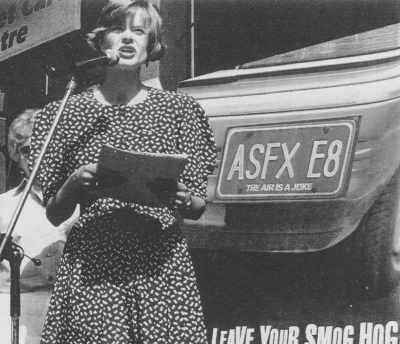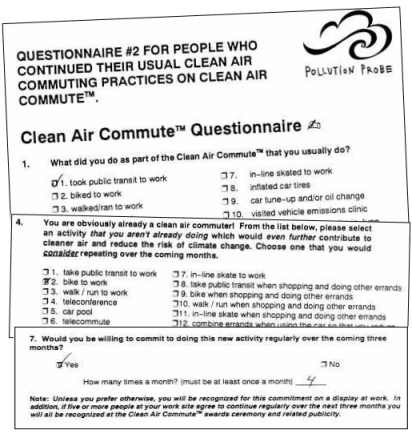The Clean Air Commute
Pollution Probe hosts an annual, month-long Clean Air Campaign to raise awareness about smog, vehicle emissions and related respiratory problems. The main event of this campaign is The Clean Air Commute, a one-day event in which employees pledge to carry out cleaner commuting practices. In 1996 a pilot was conducted to build on the one-day event and measure the resulting changes over a period of three months.
Background
The Clean Air Commute was designed to be a fun event. Companies were challenged to compete with one another by collecting points for employee participation in smog-reducing forms of transportation. By 1996, it had expanded to include the cities of Ottawa, Hamilton and Edmonton, with 190 companies and 16,000 employees participating. Despite this success, organizers had not yet measured the impact on people's ongoing transportation habits nor had specific strategies been implemented for promoting such long term changes.
Consequently, a pilot was designed to build on the one-day event and measure the resulting changes over a period of three months.
Delivering the Program
The Clean Air Commute encouraged members of the public to find cleaner means of transportation on one day during the month of June. Such means could include car pooling, taking public transit, walking, biking or rollerblading to work. Points were earned for each of these activities, as well as for working from home and undertaking car efficiency tune-ups.
A planning committee of executives from companies that had participated in the past worked to recruit new participants from local businesses (Work Programs that Influence the Home). Participating companies enlisted motivated staff members to act as coordinators, who in turn became responsible for obtaining a commitment from fellow employees to participate (Obtaining a Commitment).
The Clean Air Commute was also promoted through a month-long Clean Air Campaign, which raised awareness about the need for cleaner commuting practices. The campaign consisted of billboard advertisements, public service announcements, press conferences and other media coverage.
When a company registered its participation, a package containing colour posters, informational brochures, inserts and coupons was sent to the coordinator for distribution. The posters were displayed in the workplace, and served as a prompt during the campaign week (Prompts). T-shirts, caps, and umbrellas with campaign logos also provided prompts and increased the visibility of participation (Norm Appeals).
The brochures and inserts provided a rationale for adopting resource efficient commuting practices and contained information on the sources of smog, the problems it caused, and a list of actions individual people could take.
VIA Rail upgrades, free passes, and other valuable coupons were distributed to all Clean Air Commute participants. A draw was held for over 100 prizes related to resource-efficient commuting, such as bikes and accessories, transit passes and in-line skates. Companies sometimes supplied their own giveaways for employees as well (Financial Incentives and Disincentives).
When employees arrived at work on the day of the event, they marked the activity they undertook on a chart. Pollution Probe collected the charts and tabulated accumulated points. Recognition was later provided through an awards ceremony for companies that earned the greatest number of points and through congratulatory newspaper ads which listed all participating companies (Norm Appeals).
In 1996, a pilot program was conducted to test how to build on the one-day commitment and encourage lasting, measurable changes in commuting behaviour. Companies which participated in that year's Clean Air Commute event were targeted.
Coordinators at those companies were sent a package about three weeks after The Clean Air Commute. It included a poster, letter and questionnaire for distribution. The poster vividly communicated the smog reduction resulting from alternative transportation, depicting the savings in equivalent weights in cars. The companies displayed the poster a few days before handing out the letters and questionnaires, to stimulate interest in the pilot.
The letters were signed by a company executive and distributed along with the questionnaires to employees. The letters commended the employees for what they had already done and informed them that they had a further opportunity to participate through the pilot (Building Motivation Over Time).
The questionnaire recognized and built on the employees' past actions and ended with a request for them to agree to participate in the three-month pilot. Respondents indicated their willingness to participate and the type and frequency of smog-reducing activity they would undertake. Commitment was further developed by posting this information in a display at work sites, along with each participant's name and signature. At the end of each month, results were collected by the coordinator and marked on the display (Prompts and Norm Appeals).
Financing the Program
Clean Air Commute's administrative costs were $186,300 in 1996. This money was provided through corporate donations, government grants, registration fees, and merchandise sales. A further $451,854 of in-kind corporate donations consisted of media advertising and coverage, company newsletter and magazine notices, and prizes.
Approximately three weeks of administrative time was required to undertake the pilot.
Measuring Achievements
Of the seven companies which agreed to participate in the pilot, three were randomly assigned to serve as a control group.
The other four companies were sent two versions of the questionnaire designed to reflect the two types of participation in The Clean Air Commute event. Those employees who had undertaken an activity that they were already accustomed to doing were asked to commit to an additional activity for the three-month period. Those who had undertaken a new activity were asked if they would be willing to extend this behaviour for the same period.
A telephone survey was conducted at the end of the pilot to collect information on clean commuting practices undertaken by members of each of the groups during the three-month period. Respondents were also asked about their intentions for repeating these practices the following summer.
Results
The pilot study participants were significantly more likely to have taken public transit (four times as often), bicycled (five times as often), walked or ran to work (seven times as often), compared with their counterparts in the control group. Similar differences were reflected in their intentions for the coming summer. Interestingly, those who worked at the same location as the pilot participants and who had also taken part in The Clean Air Commute but had not agreed to participate in the pilot, reported similar overall shifts in clean air commuting to and from work. It would appear that there was a carry over from those participating in the pilot to their coworkers, perhaps through some of the normative appeals built into the pilot.
Only the pilot participants, however, were significantly more likely to have been involved in clean air commuting practices that were not work-related, for example when shopping and doing other errands. The same held true for their future intentions.
The pilot participants were also significantly more likely to have described themselves as positive and committed to these alternative commuting practices. Their co-workers, while significantly less positive and committed than the pilot participants, were still significantly more positive and committed than those in the control group.
Contacts
Olivia Nugent
Pollution Probe
625 Church St., Suite 402
Toronto, ON M4Y 2G1
T: 416-926-1907 x. 244
F: 416-926-1601
Email: onugent@pollutionprobe.org
www.pollutionprobe.org
Notes
This case study was originally published in 1998 in "Tools of Change: Proven Methods for Promoting Environmental Citizenship" by Jay Kassirer and Doug McKenzie-Mohr (Published by Canada's National Round Table on the Environment and the Economy)
Search the Case Studies


